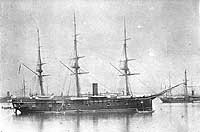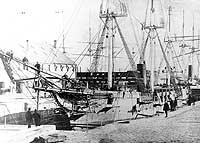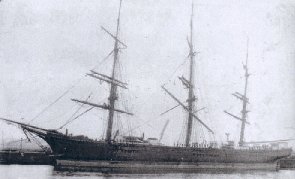
The un-attributed images on this page are taken from the American Naval History and Heritage Command. Translations into German by Google Translator.

A 3,900 ton steam frigate of the 'Contoocook' class, built at the New York Navy Yard and commissioned in February 1877, the flagship of Rear Admiral Lewis Ashfield Kimberly, USN (1830-1902), Commanding U.S. Naval Force on Pacific Station. Commanded by Captain Norman Von H. Farquhar, USN (1840-1907). She was the first American vessel to have electric lighting installed (in 1883) at a cost of $5,500. Only one unfortunate man (J. Hewlett, landsman) from the complement of 450 lost his life.
The largest warship begun for the Navy in the years between the Civil War and the beginning of "New Navy" steel ship construction in 1883, the USS Trenton suffered from a well-known defect in design in which heavy seas regularly allowed water to menace the boilers via the hawse pipes. Her length was 253 feet, beam 48 feet and draught 20 feet 7 inches. She had reputedly a good turn of speed, one which surprised the British in the Red Sea one time as being between 14 and 16 knots, but which was officially 12.6. She was armed with 7 guns on her upper deck, 2 each side, 2 forward facing and 1 rearward on the poop. Her most powerful armament were the 8 large guns, 4 each side on the gun deck. 24 furnaces fed 8 boilers arranged 4 in line on each side in an engine room 94 feet long containing equipment which alone weighed nearly 800 tons. She was fitted with a large underwater ram at the bow.

Named after a city in Illinois on the Kaskaskia River, Vandalia was a 2,033-ton Swatara class screw sloop, built at the Boston Navy Yard, Charlestown, Massachusetts and commissioned on 10th January 1876. She was 260(?) feet long, 30 feet beam, 17 feet 4 inches draught. Other reference material make her dimensions: length between perpendiculars: 216 feet; breadth of hull 39 feet; depth of hold: 20 feet. She was rated as a 12 knot ship and armed with 8 guns. From December 1877 until March 1878, she transported former President Ulysses S. Grant on a tour of the Mediterranean Sea and its historic ports.
Vandalia recommissioned in February 1886, and in August of that year left the east coast for the long voyage around South America to join the Pacific Station. She served as the Navy's Pacific flagship during much of the next two years until destroyed in the Samoan Hurricane under Captain Cornelius M. Schoonmaker, USN.
A 1,375-ton Adams class gunboat, she was built at the Washington Navy Yard, D.C., the last significant ship to be constructed at that facility. Officially, she was the Civil War gunboat Nipsic rebuilt, but she actually was a completely new ship, with a displacement more than half again that of the original. Length, 185 feet; beam, 35 feet; draught 14 feet 4 inches; a 10 knot ship, relatively slow. The new Nipsic was commissioned in October 1879 and served for several months in the West Indies. In March 1880, she crossed the Atlantic to join the European Squadron. Nipsic was transferred to the South Atlantic Squadron in Mid-1883 and remained on that station until March 1886.
Following overhaul, Nipsic went to the Pacific by way of Cape Horn in early 1888 and on to Samoa in time for the hurricane, under Commander Dennis W. Mullan, USN.
A 2,424-ton Carola class corvette, she was built at Stettin, Germany. Commissioned in September 1881, she served overseas during the rest of the decade. She spent some considerable time in the South African squadron before being despatched to Samoa in the worsening political climate of 1888 as flagship under Korvettenkapitän Baron Freiherr von Erhardt (some references spell this Ehrhardt and others give him the rank Fregattenkapitän). Her engines were reasonably powerful, capable of producing 2,200 h.p. and pushing the vessel along at 13 knots or more on a good day.
Although this vessel was the most powerful of the German fleet assembled at Apia, due to unusual German military regulations Erhardt was not the senior German Naval Commander, that position was held by Fregattenkapitän Fritze of Adler. After surviving the Samoa Hurricane, Olga returned to Germany (surviving a collision with a British merchant vessel in the Suez Canal on the way), and was soon extensively modified for use as a training ship. She continued in that role into the early years of the Twentieth Century. SMS Olga was sold in March 1906 and scrapped two years later.
Ein 2424-Tonnen-Klasse Carola Korvette wurde sie in Stettin, Deutschland gebaut. Im Auftrag im September 1881 war sie im Ausland während der Rest des Jahrzehnts. Sie verbrachte eine beträchtliche Zeit in der südafrikanischen Staffel vor in der sich verschlechternden politischen Klima von 1888 als Flaggschiff unter Korvettenkapitän Baron Freiherr von Erhardt (einige Referenzen Zauber dieses Ehrhardt und andere geben ihm den Rang Fregattenkapitän) nach Samoa geschickt werden. Ihre Motoren waren recht stark, fähig zur Herstellung von 2,200 H. P. und Schieben des Schiffes entlang bei 13 Knoten oder mehr an einem guten Tag.
Obwohl dieses Schiff der stärkste der deutschen Flotte in Apia versammelt war, aufgrund ungewöhnlicher deutschen militärischen Vorschriften Erhardt nicht die älteren deutschen Marinekommandant war, wurde diese Position von Fregattenkapitän Fritze von Adler gehalten. Nach dem Samoa Hurrikan überleben, kehrte Olga nach Deutschland (eine Kollision mit einem britischen Handelsschiff in den Suezkanal auf dem Weg zu überleben), und wurde bald in großem Umfang für die Verwendung als Schulschiff verändert. Sie fuhr fort, in dieser Rolle in den frühen Jahren des zwanzigsten Jahrhunderts. SMS Olga wurde später März 1906 und verschrottet 2 Jahre verkauft.
A 1,040-ton gunboat, with a composite iron and wooden hull, she was built at Kiel, Germany and launched 3rd November 1883. She was commissioned in May 1885 and served overseas for her entire career. Her 950 h.p. engines could propel the vessel at just over 11 knots in a good sea. Armed with five 12.5 cm (5 inch) and five 3.7 cm (1.5 inch) cannon and crewed by approximately 127 officers and men, she was 61.8 metres long, 8.8 metres in breadth and 4 metres depth of keel. Whilst Olga was undoubtedly the most senior German vessel present, the Adler's commander, Fregattenkapitän Fritze, was in fact the senior German Naval officer at Samoa.
The wreck of the Adler remained on the reef for many years, finally succumbing when the western part of the reef was reclaimed; in the 1970s the new Government Building at Apia is believed to have been built on top of, or very close to, the final resting place of the ship.
Ein 1,040-Tonnen-Kanonenboot, mit einem Composite- Eisen und Holzrumpf , wurde sie in Kiel, Deutschland gebaut und 3 November auf den Markt 1883. Sie Mai 1885 und diente in Übersee für ihre gesamte Karriere in Auftrag gegeben wurde. Ihre 950 H. P. Motoren konnte das Schiff bei knapp über 11 Knoten in einem guten Meer treiben. Bewaffnet mit fünf 12,5 cm (5 Zoll ) und fünf 3,7 cm (1,5 Zoll ) Kanone und Crewed von etwa 127 Offiziere und Soldaten, sie war 61.8 Meter lang, 8.8 Meter breit und 4 Meter Tiefe von Kiel. Während Olga zweifellos die älteren deutschen Schiffes anwesend war, der Adler- Kommandant, Fregattenkapitän Fritze, war in der Tat der ältere deutsche Marineoffizier auf Samoa.
Das Wrack der Adler auf dem Riff blieb für viele Jahre zu erliegen, schließlich, als der westliche Teil des Riffs zurückgewonnen wurde; in den 1970er Jahren wird die neue Regierungsgebäude in Apia glaubte oben auf oder ganz in der Nähe, die letzte Ruhestätte des Schiffes gebaut wurden.
Launched 15th September 1887 Eber, a 760-ton iron-hulled gunboat, was also built at Kiel, Germany. She was 51 metres long, 8 metres breadth and 3.8 metres depth of keel. She carried approximately 87 officers and crew and was armed with 3 cannon. After commissioning in September 1887 she was sent to the Pacific for active service. There seems to be little further information available about this vessel. She had been involved in a number of the skirmishes in Samoa in the few months of conflict between Germany and the Samoan natives prior to the Samoan Hurricane. She was commanded by Kapitänleutnant Wallis, who taken over the role when she had first arrived at Apia in November 1888.
I have located just this one photographic image of the vessel prior to the storm, and it appears to reinforce the suggestion she and SMS Adler were of very similar designs, the location of the funnel being the most striking difference. Even the American Admiral Kimberly, who appears to have been something of a draughtsman and had sketched many of the ships in Apia harbour, does not seem to have spent much time on the little gunboat - there again, he had little time to do so before she was wrecked. She was the smallest in the harbour, and powered by her 760 h.p. engine, was capable of 11 knots.
She had been damaged in the storm which hit the bay a couple of weeks earlier, when her propeller touched the reef. This seriously impaired the functioning of the screw, and put the whole shaft out-of-balance. This would have meant that had she used her screw at full revolutions for any significant period of time, it would almost certainly have ruined the bearings and caused the engine to fail. The crew were therefore severely handicapped when the hurricane hit - caught in the dilemma that they needed maximum power from the engine, but to run it that way risked losing it altogether. Recognising this danger even before the storm hit, her Kapitan Wallis had repeatedly requested permission to leave the bay and weather the approaching storm at sea, but this had been refused by Fritze on Adler. The decision cost 73 men their lives. The crew did very well nursing their engine, using it in short bursts to try and stay off the reef, but really they were doomed from the outset.
Gestartet 15 September 1887 Eber, ein 760-Tonnen-Eisen-geschälten Kanonenboot wurde auch in Kiel, Deutschland gebaut. Sie war 51 Meter lang, 8 Meter breit und 3.8 Meter Tiefe von Kiel. Sie trug etwa 87 Offiziere und Besatzung und wurde mit drei Kanonen bewaffnet. Nach der Inbetriebnahme wurde im September 1887 sie für den aktiven Dienst in den Pazifik geschickt. Es scheint wenig weitere Informationen zu diesem Schiff zu sein. Sie hatte in einer Reihe von Gefechten in Samoa in den wenigen Monaten des Konflikts zwischen Deutschland und den samoanischen Eingeborenen vor der Samoaner Hurricane beteiligt. Sie wurde von Kapitänleutnant Wallis, die über die Rolle genommen geboten, wenn sie zum ersten Mal in Apia im November 1888 gekommen war.
Ich habe nur diese eine fotografische Bild des Schiffes vor dem Sturm befindet, und es scheint, den Vorschlag, sie und SMS zu verstärken Adler waren sehr ähnliche Entwürfe, die Lage des Trichters ist der auffälligste Unterschied. Auch der amerikanische Admiral Kimberly, der etwas von einem Zeichner gewesen zu sein scheint, und hatte viele der Schiffe in Apia Hafen skizziert, nicht viel Zeit auf dem kleinen Kanonenboot verbracht zu haben scheint - wieder da, hatte er wenig Zeit, so zu tun, bevor sie wurde zerstört. Sie war die kleinste im Hafen, und angetrieben von ihrem 760 H. P. Motor, war von 11 Knoten fähig.
Sie hatte in den Sturm, die die Bucht ein paar Wochen traf früher beschädigt wurde, wenn ihr Propeller das Riff berührt. Diese intensiv in die Funktion der Schraube beeinträchtigt wird, und legen Sie die gesamte Welle aus dem Gleichgewicht geraten. Dies hätte bedeutet, dass hatte sie ihre Schraube bei voller Umdrehungen für jeden längeren Zeitraum verwendet werden, wäre es fast sicher haben die Lager zerstört und verursacht der Motor zum Scheitern verurteilt. Die Besatzung war deshalb schwerbehindert, wenn der Hurrikan zuschlug - in dem Dilemma gefangen, dass sie maximale Leistung aus dem Motor benötigt, aber es auf diese Weise aufs Spiel gesetzt zu laufen sie ganz zu verlieren. In Kenntnis dieser Gefahr, noch bevor der Sturmerfolg, sie hatte Kapitan Wallis wiederholt bat um Erlaubnis, die Bucht und Wetter das nahende Sturm auf dem Meer zu verlassen, aber das war von Fritze abgelehnt worden auf Adler. Die Entscheidung kostete 73 Menschen ihr Leben. Die Mannschaft hat sehr gut Pflege ihres Motors, ist es in kurzen Schüben mit dem Riff zu versuchen und bleiben weg, aber wirklich waren sie von vornherein zum Scheitern verurteilt.

Various reports and reference sources list the other ships, though in many cases the spelling is contradictory and on occasion, a different name entirely appears. From all these other ships, whatever their name and size, only one vessel - unfortunately unidentified - would emerge, and by no means unscathed. Thrown high onto the beach by virtue of being located nearest in, she survived the rigours of the hammering waves suffering damage which the American Carpenters made short work in repairing. She was refloated within a day or two, and despatched to intercept the fast mailboat on its run from Honolulu to Auckland with the terrible news of the disaster. She made poor work of the passage and needed a tow from Calliope in order to reach the rendezvous point at Tuituila.
The names here I have taken from a newspaper report in the "Queenslander", Brisbane, dated Saturday, April 6, 1889. In brackets are some of the alternate spellings I have encountered. All these vessels were reported as lost.
The Lily was run down at her mooring by USS Nipsic as the latter vessel made its desperate attempt to beach on the eastern shore of the bay. On board were her master Mr. Douglas; Mr. Ormsby, a merchant trader for the firm of MacArthur's; and the ship's un-named Hawaiian cook. Mr. Douglas was able to struggle to Olga where he was dragged aboard virtually senseless, but where later he helped guide the German ship to the shore when she herself beached. The others did not survive. The crews of virtually all the other vessels had prudently left their ships on the Friday.
J.C.Godeffroy & Company, Hamburg were Merchants & Shippers trading in the Pacific and regularly calling at Apia. The company had become bankrupt and closed in 1879 and its founder, Johann Caesar Godeffroy, died in the year 1885. The company certainly ran a vessel named Peter Godeffroy - along with a number of similar vessels - and it is probable the vessel lost at Apia is the same ship, although ships sold in bankruptcy were most usually renamed by their new owners, especially if they repeated the name of a failed dealer.
J.C.Godeffroy & Company, Hamburg waren Händler & Versendern Handel im Pazifik und regelmäßig in Apia anrufen. Das Unternehmen bankrott geworden war und im Jahre 1879 und seinen Gründer geschlossen, Johann Cäsar Godeffroy, starb im Jahr 1885. Das Unternehmen lief sicherlich ein Schiff namens Peter Godeffroy - zusammen mit einer Reihe von ähnlichen Gefäßen - und es wahrscheinlich ist das Schiff in Apia ist das gleiche Schiff verloren, obwohl in Konkurs verkauft Schiffe am häufigsten von ihren neuen Besitzern umbenannt wurden, vor allem, wenn sie den Namen eines ausgefallenen Händler wiederholt.